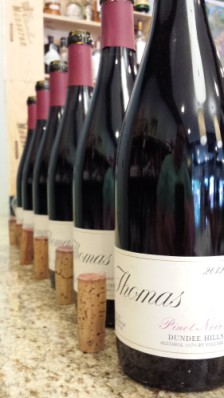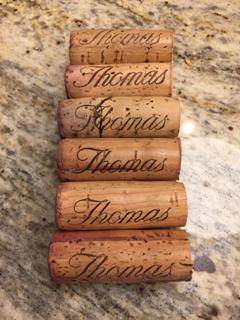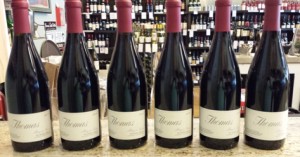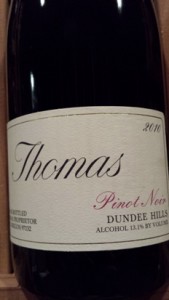The month of May was Oregon Wine Month, and while I am not sure by what authority that designation was made, I nonetheless enthusiastically embraced the opportunity to drink more Oregon wines.
In honor of Oregon Wine Month, I thought it would be fun to put together a tasting of one of the best, but also one of the least-widely known, Oregon Pinot Noirs. Several weeks ago, I invited a handful of central Ohio’s accomplished wine and food professionals to join me in tasting six vintages of the John Thomas Dundee Hills Pinot Noir. We tasted and evaluated the 2007 through the 2012 vintages. Spoiler alert: they were fabulous!
The Wines of Oregon
The story of modern Oregon wines begins in the 1950s and 1960s when a few hardy pioneers decided, against all advice, to try to grow vitis vinifera, wine grapes, in Oregon. Common wisdom was that, unlike California, Oregon was too cool and too wet for serious wine production, and prior to the mid- to late-1960s, what little Oregon wine there was came from the vitis labrusca or table grape variety.
I recently read Paul Pintarich’s book The Boys Up North: Dick Erath and the early Oregon Winemakers. Published in 1997, Pintarich tells the story of the birth of the wine industry in Oregon. Today, when most people think of Oregon wine, they think of the Willamette Valley, and not without reason. Of the 18 American Viticultural Areas (AVAs) in Oregon, one-third are concentrated in the Willamette Valley. It is home to 74 percent of Oregon’s vineyards and produces 88 percent of Oregon’s Pinot Noir. David Lett, known as Papa Pinot, planted the first Willamette Valley Pinot Noir in his Eyrie Vineyard in May of 1965. But the first and longest continually-operating vitis vinifera-based wine producer was south of the Willamette Valley, Richard Sommer’s Hillcrest Vineyard in the Umpqua Valley.
Charles Coury, Dick Erath, Richard Ponzi and David Adelsheim, along with Sommer and Lett and a few others, were the first wave, the real pioneers of the Oregon wine industry. They believed, and have been proven right, that there are similarities in climate between Willamette and Burgundy, and that the Willamette soils would be well-suited to Pinot Noir. From their dogged determination and hard work, Oregon has become a thriving producer of world class wines.
In 1972, there were only a dozen commercial wine grape growers in Oregon; by 1997, there were 120 vineyards. Today there are over 800 vineyards and 600 wine producers in 18 different AVAs throughout Oregon. More than Pinot Noir, Oregon winemakers are now producing world class Pinot Gris and crisp, acidic Chardonnay among dozens of other varietals being grown in the state. As examples, I am absolutely crazy for Lange Estate Winery and Vineyard’s Tempranillo and I am wildly curious to see how John Paul Cameron’s Nebbiolo translates that native northern Italian grape to the soils of the Dundee Hills. Many producers are also sourcing fruit from Northern California and Washington, adding to the great variety of wines available labeled “Made in Oregon.”
A Little Bit about John Thomas and His Pinot Noir
It is difficult to learn much about John Thomas and the way he makes his wine. I met him only once, and then only to shake his hand and say “nice to meet you.” What I know has come from a couple bloggers who have been to his vineyard, or snippets in on-line wine forums. I know people in Portland who know him casually, and they confirm what I have read, that Thomas is a very private person. He does not have a tasting room, does not have public events and does not even have a website for his winery.
John Thomas was not a part of the first wave of Oregon winemakers, but he was close. He planted his vineyard in 1984, with his first commercial bottling in 1988. For several years after that he sold all his fruit to Domaine Druhin. He produced Thomas Pinot Noir in 1991, but in 1992 and 1993 he declassified the fruit, meaning that he did not feel it was up to standard for his top label. In years he declassifies fruit, he produces a second label, Acme Wineworks Pinot Noir, as he did in 1992, 1993 and 1995. In some later years he declassified part of his harvest and produced both labels.
Except for those vintages where he declassifies some of the fruit, Thomas produces only one wine, his Dundee Hills Pinot Noir. Each year, he produces a very small amount, less than 400 cases from a very small plot of land of less than five acres. Thomas works essentially by himself, from planting and maintaining the vines to loading up his truck and delivering cases of wine to restaurants and wine stores in the Portland area.
He has been described as a vigneron, what the French refer to as a wine grower, which refers to those winemakers who believe that wine is made in the vineyard. Once the grapes are harvested, there is very little additional manipulation. The winemaker, at that point, gets out of the way of grapes, allowing them to become the wine they were intended to be.
That type of winemaking respects the terroir of the vineyard, that is to say, it makes use of the soil and the climate and the weather, to produce a wine that captures the character of the place and the moment from which it comes. I have seen Thomas’ wines referred to as the most Burgundian of American Pinot Noirs. I think some people confuse that, thinking it means it tastes just like a wine from the Cote d’Or. In reality, it means that the wine tastes like where it was grown, in this case, a small plot of land in a corner of the Dundee Hills AVA in the Willamette Valley.
The Judgment
All wines are subject to seasonal variations in temperature, cloud cover, rainfall, insects, disease and the like, but in general, the lesser the manipulation in the winery, the greater the opportunity for variation across vintages.
Growing conditions in the Willamette Valley were widely variable in the 2007 through 2012 vintages. 2008 and 2012 were considered two of the greatest vintages of the past 35 years, with moderate to warm daytime temperatures and cooler nights that preserved the acidity of the fruit and provided for full and even ripening. 2010 and 2011 were wet and cool in the spring, leading to late bloom. 2010 returned to normal patterns in July, but because of the late start, many growers had to reduce the number of grape clusters on the vines to ensure the ripening of those that remained. The resulting fruit was good, but yields were down significantly. 2011 is called a “miracle harvest,” because the cool and wet growing conditions remained a challenge until September. 2011 saw one of the warmest Septembers on record and then had warm, dry weather to extend the growing season into November. Harvest was very late, but to the surprise of many, 2011 produced some high quality fruit. 2009 was warmer than normal without excessive rain, leading to fully ripe fruit, although acid levels remained good. 2007 saw wet and cool weather early in the growing season, and rains returned in September and October.
Much of the vintage variation is apparent in the wines we tasted. Alcohol levels ranged from 13.1 percent for the 2010 vintage to 13.9 percent for the 2009. The fruit on the 2009 was more ripe, and seemed to include more blue fruit than the red fruits that dominated the other vintages. The 2007 and the 2009 also seemed a little out of balance and less integrated relative to the other vintages.
On the other hand, those variations occur at the margins. It became clear as we tasted these wines that there is a consistency of character that says, “This is Thomas.”
The first clue is the level of extraction evidenced by the amount of color visible in the wine. Even in the more ripe 2009 vintage, if you held up your hand and looked at it through the glass of wine, you could see your hand. I believe that controlled extraction is very important to creating a wine with balance between fruit and acid. There are certain flavor characteristics that also appeared across the vintages. There is an earthiness on the nose, reminiscent of dirt, leaves and mushrooms. There is a spice note that bridges the nose to the entry on the palate, which then evolves into sour cherry, fairly traditional for a Dundee Hills Pinot Noir, and raspberry. There is also a solid tannic structure that goes beyond what you might expect for the level of extraction, perhaps indicative of the quality of the fruit that makes up these wines.
All of these wines were spectacular. There was a point when we were tasting the 2009, which I believe was unanimously considered our least favorite of the six vintages, when Steve Hamm, who has tasted at least tens of thousands of wines around the world in his 35+ year career in the wine business, started to chuckle. The point he made was that the 2009 Thomas is a gorgeous wine of great balance and complexity. Yet because we set out to compare these different vintages, we were finding these minute differences in quality or taste to highlight.
The group was split on which vintage we considered the best of the six, although a majority of the group seemed to favor the 2010, which was also my favorite. As I have written before, when we talk about best/worst or favorite/least favorite, that is all relative to our individual preferences in wine. One can objectively state that one wine is more complex or has a higher percentage of alcohol than another, but what is a good wine, or a better wine, is subject to what each of us prefers.
I found the 2010 to be my favorite because, of the six vintages, it best expressed these characteristics. I love the earthiness it exhibited on the nose, and I prefer a wine in which the fruits are expressive, but not dominant, as was the case here with tart cherry and raspberry. I also like a wine that is integrated, and by that I mean each phase, flavor or experience in the wine draws you into the next. Here, for example, it was not that you smelled earth and then you tasted cherry, rather the earth tones lingered while the fruit notes began to grow on the palate. I also like a wine that is leaner and less fruity overall, with a gripping acid. The acid in the 2010 made my mouth water and left me in anticipation of the next taste, while at the same time savoring the strong but soft tannins and the very long finish. The 2010 is an extraordinary wine that seemed to be the most elegantly, fully integrated of the six.
The group’s next favorite was the 2012. Made from riper fruit, it had a little more alcohol and, to my palate, just the slightest hint of under-ripe blueberry to go with the tart cherry and raspberry. We all agreed that it was very much like the 2010, except that it had not had the same amount of time to integrate and balance. While the 2010 was the group’s favorite that day, Jonna Brandon, owner of the Twisted Vine, also one who preferred the 2010, summed up our feelings about the 2012 when she said, “Just imagine how good this will be two years from now.”
We found the 2008 to be our third favorite, and the 2011 came next. I believe the 2011 also suffers from its youth, and that it has the potential to develop into a wine every bit as good as the 2010 or the 2012. The 2007 came next, followed by the 2009. Each of those seemed ever-so-marginally disjointed relative to the others. But as I noted earlier, these perceived differences in quality and preference are tiny, and all six of these wines were true pleasures to experience.
In addition to Steve Hamm and Jonna Brandon, I would very much like to thank Steve Gifford of Vintage Wine Distributors, Chef Alana Shock and Kevin Bertschi from Alana’s Food and Wine, Robin Christophersen, published author who also works with Jonna at the Twisted Vine (her first book is available at Amazon.com), and her husband Roy Clark, for joining me for this tasting. It is always interesting to hear what people with experienced and educated palates think about the same wines. I also firmly believe that wine is a social drink, meant to be shared among good friends. That certainly added great enjoyment to this tasting experience.
A word about value. As we tasted these wines, we were not thinking in terms of these being good wines for whatever X-number of dollars they cost. These are simply spectacular wines. It is a bonus that these wines are not expensive relative to many other great wines. The John Thomas Dundee Hills Pinot Noir retails for about $50, considerably less than many Premier Cru or Grand Cru Burgundies, and less even than many other Oregon Pinot Noirs. The catch is that it is nearly impossible to find. Thomas just does not make very much wine, and it is highly sought after by those who know it. On the secondary market, on those occasions you can find a Thomas wine at winebid.com or one of the other auction sites, they are in the $125-range per bottle. Still, less expensive than a lot of Grand Cru Burgundies, and you would be hard pressed to find more enjoyable wines.




Great read. What truly did it for me was tasting the 1997 Thomas in 2009. Even from that “challenging” vintage John Thomas produced an exquisite, nuanced that shone with 12 years on it.
Thanks! I picked up a magnum of the 1999 Thomas a couple years ago at an auction. I have read that ’99 was a very nice year in the Willamette Valley and I am very interested in tasting the ’99. Just trying to figure out the right occasion!